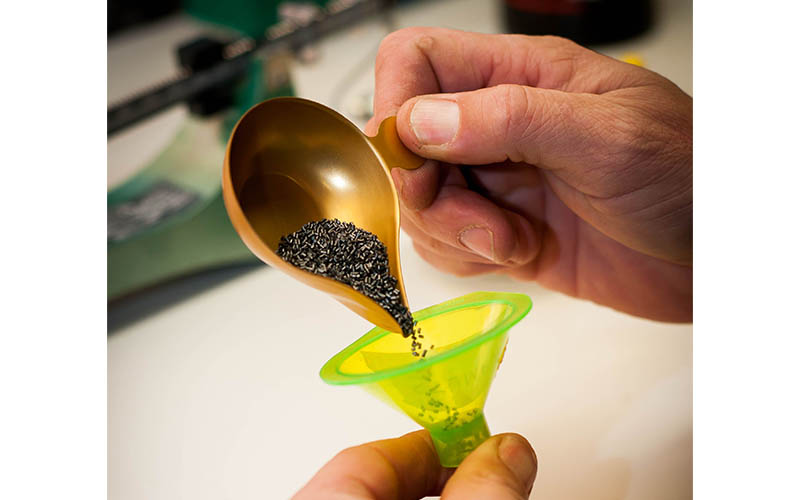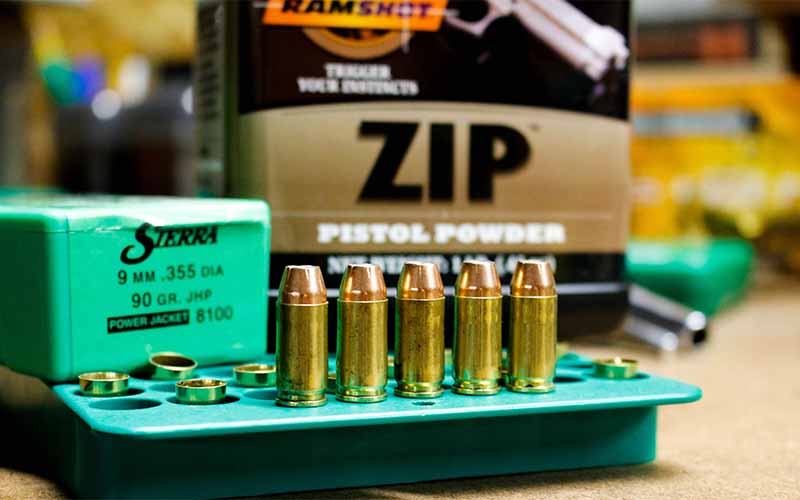
Whether you want your handloads to perform as consistently as possible or just enjoy having all your fingers, it pays to weigh your powder charges.
Smack in the middle of my reloading bench proudly sits a RCBS MatchMaster electronic powder dispenser. It’s fast, it’s accurate, it’s precise … and it has the potential to weigh powder charges to 0.04 grain. While I think the world of this high-tech machine and its capabilities, in some instances it might be too much, especially considering the cost (street price is right around $900) to the average reloader. Like so many pieces of cutting-edge technology, the new features can be fantastic.
But, every reloader must ask one simple question: Do I need this?

Significant Digits
Strolling into my local gun shop, I found proprietor and friend Geoff Koonz modifying his Redding Model No. 2 balance beam scale to make it a bit easier to get his fingers to the leveling adjustment screw. I use the same model, and it prompted a conversation about reloading technology and just how precise things need to be.
One of the often-unexpected side effects of being a writer with a full schedule is that many of the activities I used to enjoy for relaxation and personal enjoyment have become part of my job. So, when I head to my bench, it’s usually for the purposes of testing some part of the equation for a hunt, article, book or some combination thereof, and it was nice to see Koonz leisurely sorting out his gear to load some pistol ammo.
“I keep things low-tech; I’m really not in a rush,” he reported. Koonz makes good use of his Redding powder throwers, taking care to dial the unit to the precise load, and checking the weight of every tenth load or so on that balance beam scale.

I’ve felt that weighing every single powder charge, no matter what the purpose of the ammo, would give me the best ammunition I could possibly make, yet so many small-bore benchrest shooters load their cartridges by volume rather than weight. Am I wasting time by weighing every powder charge, especially for ammunition designed for hunting or plinking?
Well, sometimes yes and sometimes no.
At one point, way, way back in the 20th century, I loaded some .308 Winchester ammo using the plastic scoop provided by the Lee Reloading Company. It was strictly volumetric, and not exactly precise, but I do remember that ammunition printed about 1½ MOA and filled the freezer with venison. I had no means of observing velocities, and at Northeast woods ranges, it didn’t matter. Was it match grade? Certainly not, but I had fun that deer season.
Now, looking at the volume of a .308’s powder charge—somewhere in the neighborhood of 43 grains of IMR 4064—a few tenths of a grain up or down might not be the end of the world. Let’s suppose that your powder charge was off 0.3 grain; you’re looking at an error of less than 0.07 percent of the target weight. Switch cartridges to a .300 Winchester Magnum, with a powder charge of somewhere in the 70-grain range, and that 0.3 grain becomes even less significant.
Change things to a pistol cartridge—whether the 9mm Luger, .38 Special or .45 ACP—and that weight variation becomes glaringly important. With charge weights almost certainly coming in at less than 10 grains, 0.3 grain becomes not only an obviously larger percentage, but in some instances, downright dangerous. With all three of the popular pistol cartridges mentioned, the difference between minimum load and maximum load is 1 grain of powder.
Supposing you’ve found optimum accuracy and velocity at a charge weight on the higher end of the safe spectrum, a weight deviation of 0.3 grain could easily push things into the red—hence my personal apprehension when it comes to progressive presses, with their unweighed powder charges and tendencies to be run for efficiency rather than precision.

Precision Or Perfection?
So, should speed and efficiency take a backseat to precision in charge weight and, ultimately, safety? My opinion is no. At the risk of sounding preachy, in this era of excellent gear—much of which is available at a lower price point than ever before—we can check the variables like powder charge weight without compromising the schedules. I love the speed and repeatability of the Dillon progressive, but I still want to stop every so often and check the powder charge weight to make sure I haven’t cranked out 50 uniform, yet dangerous, cartridges.
I’ll have guys swear to me that, in all their years, they haven’t seen a deviation from the powder thrower, or that a balance beam scale has never mysteriously slipped out of zero, or that the electronic scales have never given a false reading. I don’t buy it. Reloading is like anything else: If you do it long enough, strange things are bound to happen.
I like my anatomy in its current configuration, and I do like most of my firearms, so I’ve learned to err on the side of caution. That said, I feel that you need to look at the percentages and balance the need to stay safe with the need for speed. In a rifle cartridge, unless you overload it by a large amount—say a couple of grains—you might lose precision on the target, but odds are you’ll stay safe. In a pistol cartridge, that could easily spell disaster.

If you’re loading for long-range work, the attention to detail will certainly pay off, as the smallest deviation in muzzle velocity will really show itself out past 1,000 yards. I don’t know of any serious long-range shooter who loads their own ammunition and doesn’t weigh every powder charge to the most precise level possible. A deviation of 15 fps can cause problems when the distances get long, so those shooters want to take every step to ensure they keep things as uniform as possible.
So, from throwing powder without weighing it at all—in the volumetric manner of benchrest shooters at closer ranges—to weighing every tenth load or so, to those who insist on weighing every charge, there are differing levels of precision for the varying applications.
Personally, I can’t get past the concern that something has been overloaded and will continue to weigh each and every powder charge, whether it takes more time or not. I sleep better knowing exactly what was put into each cartridge, and that I didn’t overload anything.
Murphy, his law and I are far too well acquainted.
Editor's Note: This article originally appeared in the July 2023 issue of Gun Digest the Magazine.
More On Reloading:
- Tips For Reloading the .30-06 Springfield
- Loving Your Luger: Reloading the 9mm Luger
- Handloading: Tips For Reloading The 7mm Rem Mag
- How To: Tips For Reloading the .223 Remington
- Reloading Bench: The Inside On Reloading For The .30-30 Winchester

Next Step: Get your FREE Printable Target Pack
Enhance your shooting precision with our 62 MOA Targets, perfect for rifles and handguns. Crafted in collaboration with Storm Tactical for accuracy and versatility.
Subscribe to the Gun Digest email newsletter and get your downloadable target pack sent straight to your inbox. Stay updated with the latest firearms info in the industry.

![Best Concealed Carry Guns In 2025 [Field Tested] Wilson Combat EDC X9S 1](https://gundigest.com/wp-content/uploads/Wilson-Combat-EDC-X9S-1-324x160.jpg)


![Best 9mm Carbine: Affordable PCCs [Tested] Ruger Carbine Shooting](https://gundigest.com/wp-content/uploads/Ruger-Carbine-Shooting-100x70.jpg)
![Best AR-15: Top Options Available Today [Field Tested] Harrington and Richardson PSA XM177E2 feature](https://gundigest.com/wp-content/uploads/Harrington-and-Richardson-PSA-XM177E2-feature-100x70.jpg)
